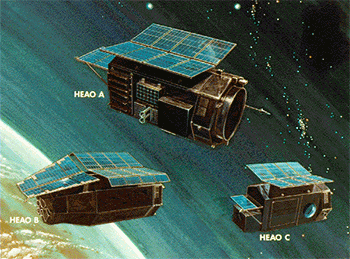High Energy Astrophysical Observatory Series
High Energy Astrophysical Observatory Series

An artist's impression of the three HEAO spacecraft. (Credit: NASA)
The High Energy Astrophysical Observatory satellites, or HEAO for short, were a series of large satellites for X-ray and gamma-ray astronomy and cosmic ray studies.
Lifetime: August 1977 (launch of HEAO-1) - May 1981 (end of HEAO-3 mission)
Country (primary): United States
Primary Science
The HEAO program was aimed at exploring the high-energy sky. HEAO-1 surveyed the X-ray sky almost three times over the 0.2 keV to 10 MeV range and provided nearly continuous monitoring of X-ray sources near the ecliptic poles. HEAO-2, or the Einstein Observatory, was the first X-ray telescope capable of imaging that was put into space. It was also the first of NASA's X-ray missions to allow astronomers to apply for time to observe specific sources (this is called a Guest Observer program). HEAO-3 surveyed the sky in hard X-rays and gamma rays and measured the composition of cosmic rays.
HEAO-1
Lifetime: August 1977 - January 1979
Science Highlights
- Complete flux-limited survey of the high galactic latitude sky
- Measurement of the X-ray background in the 3 to 50 keV range
- Comprehensive catalog of X-ray sources
- Monitored the X-ray variability of a range of objects from active galactic nuclei to X-ray binaries
Links to more information
Einstein Observatory/HEAO-2
Lifetime: November 1978 - April 1981
Science Highlights
- First high resolution spectroscopy an morphological studies of supernova remnants
- Resolved many X-ray sources in our neighbor galaxies, Andromeda and the Magellanic Clouds
- First study of the X-ray emitting gas in galaxies and clusters of galaxies revealing cooling inflow and cluster evolution
- Detected X-ray jets from Centaurus A and M87 aligned with their radio jets
- First medium and deep X-ray surveys
- Discovery of thousands of "serendipitous" sources
Links to more information
HEAO-3
Lifetime: September 1979 - May 1981
Science Highlights
- Sky survey of gamma-ray narrow-line emission

